 |
Alitrunk with low or no mesonotal
welt
|
-- |
Hypostomal teeth
(non-type)
|
35
|
Head distinctly longer
than wide fully striate and
parallel-sided |
Section 7 |
|
| -- |
Head length and width near equal but with
short frontal carinae, no scrobes and short scapes (SI max 50) |
36 |
|
--
|
Head length and width
near equal but with distinct long frontal carinae, shallow scrobes and
most with long scapes (SI ca 60-65) |
Section 8 |
|
|
HL near equal to HW |
-- |
|
| 36 |
Head fully striate and
parallel-sided; postpetiole squamiform (with anterior ventral process,
smaller process on anterior ventral petiole); funiculi filiform |
37 |
|
| -- |
Head never fully striate and with at least
weakly convex sides |
38 |
|
| - |
Major head fully striate and parallel-sided |
-- |
|
| 37 |
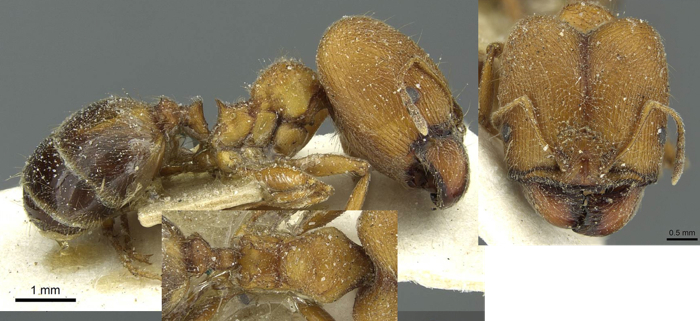
TL
ca 8.0 mm, HL ca
3.0, HW ca 2.8, SL ca 1.4, PW 1.33; CI 89, SI 50; dark ferruginous red,
extremities darker brown to blackish |
. |
|
| . |

TL
2.7 to 3 mm, HL 0.79, HW 0.71, SL 0.86, PW 0.45; CI 92, SI 120; head
subrectangular, as broad in front as
behind, with straight, subparallel sides, rounded posterior corners and
nearly straight posterior border; eyes convex, at the middle of the
sides; mandibles rather large, deflected at the tip, with denticulate
apical borders and two larger terminal teeth; clypeus distinctly
carinate, with the anterior border very feebly sinuate in the middle;
antennal scapes extending one-third their length beyond the posterior
corners of the head; promesonotum profile convex; propodeal dorsum a
little longer than the declivity; spines slender, acute, erect, about
half as long as their interval; petiole slender, twice as long as
broad, scarcely broader behind than in front, with the sides only very
faintly concave; node transverse, its border distinctly notched in the
middle; postpetiole twice as broad as the petiole, as long as broad,
subglobose, not toothed on the ventral side; gaster about as large as
the head; shining; mandibles subopaque, finely striatopunctate; sides
of head delicately longitudinally rugulose and reticulate; alitrunk,
petiole, and postpetiole finely and densely punctate, opaque; upper
surface of pronotum and postpetiole smooth and shining; gaster and legs
shining, sparsely punctate; erect hairs fine yellowish; scapes, like
the legs, with numerous oblique hairs; brown; head darker above and
behind; gaster, except the edges of the segments, middle portions of
legs, fore coxae, and usually also the pronotum and upper surfaces of
the petiolar nodes, darker than the posterior portion of the thorax. |
Zaïre -
saxicola |
|
| -- |

TL
4.0-4.3 mm, HL 1.47, HW 1.25, SL 1.0, PW 0.56; CI 84, SI 80; head
relatively long & narrow, sides near straight; with
relatively long narrow propodeal spines; head and
alitrunk dull with fairly close reticulation, on head latter overlaid
with coarse rugose reticulation; pilosity yellowish, pubescence sparse
to nil on body, long oblique on appendages; dark yellowish-brown to
brownish-red |
. |
|
| . |

TL
2.6-3.0 mm, HL 0.69, HW 0.54, SL 1.04, PW 0.38; CI 76, SI 188;
postpetiole with distinctive pyriform shape; head
and alitrunk dull with fairly close reticulation, on head latter
overlaid with coarse rugose reticulation, middle of vertex shiny;
pilosity yellowish, pubescence sparse to nil on body, long oblique on
appendages; dark yellowish-brown to brownish-red
Major and minor seemingly unique so key placement by default
|
Zimbabwe
- maufei |
|
| . |
Major head never fully striate and not
parallel-sided |
. |
|
| 38 |
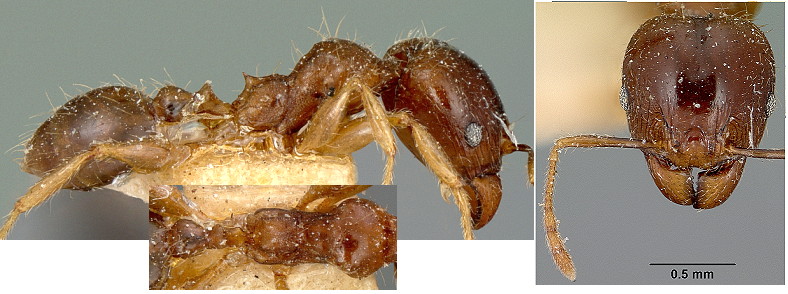
TL
ca 3.5 mm; head shape distinct - West African & Congo Basin records
dubious |
. |
|
| . |
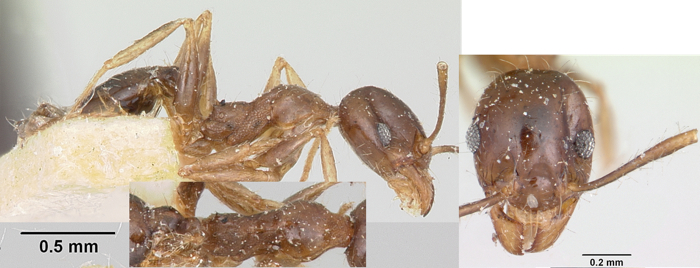
TL
ca 2,7 mm, HL 0.60, HW 0.49, SL 0.65, PW 0.32; CI 82, SI 119; small red
brown with evenly ovoid head and the minute propodeal spines
|
Madagascar
- picata |
|
--
|
Major head otherwise
|
39
|
|
| 39 |
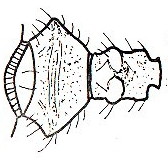 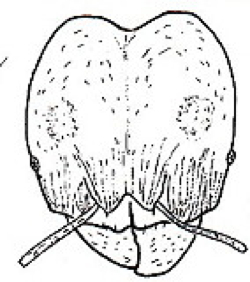
Major head
cordiform (heart-shaped); propodeal spines upturned, stout and blunt;
postpetiole profile globular, in dorsal view wider than long, hexagonal
with rounded lateral prominences |
40 |
|
| -- |
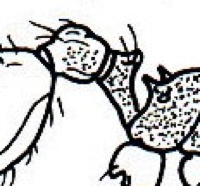 
Head in
full-face view with only moderately convex sides;
mandibles relatively slender, with at most reduced teeth or denticles;
funiculus segments quadrate; postpetiole trapezoidal but without
elongated lateral prominences, ventrally concave, giving profile a
somewhat globular appearance |
43 |
|
| - |
Major
head cordiform |
-- |
|
| 40 |
Colour dark brown to
black; major head CI ca 100
|
41 |
|
| -- |
Colour lighter; major head CI ca 105
(wider than long)
|
42 |
|
| 41 |

TL 4.3 mm, HL 1.55, HW 1.5,
SL 0.75, PW 0.70; CI 97, SI 50; posterior
of head with
shiny areas on vertex; black or very dark brown with anterior of head
and sides of mesonotum red-brown |
. |
 |
| . |
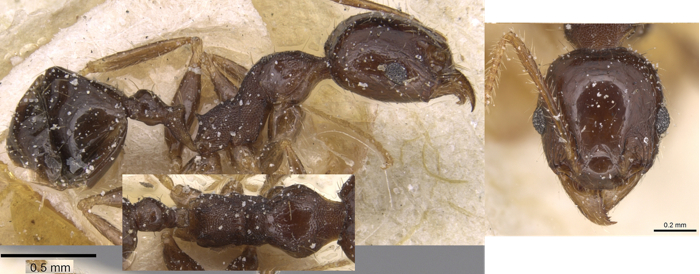
TL
3 mm, HL 0.67, HW 0.59, SL 0.67, PW 0.39; CI 92, SI 110; head longer
and more rounded posteriorly;
head polished and shiny with little or no sculpturation; dorsum of
alitrunk more strongly sculptured; propodeum longer with
stronger spines; erect pilosity quite sparse; black or very dark brown,
appendages and mandibles
brownish. |
West
Africa & Congo Basin - melancholica |
|
| -- |

TL 4.6-5.0 mm, HL
1.44, HW 1.44, SL 0.88, PW 0.64; CI 100, SI 61;
occipitum matt with rugulo-reticulation;
dorsum of propodeum a third longer than wide; major and minor brown
with reddish appendages |
. |
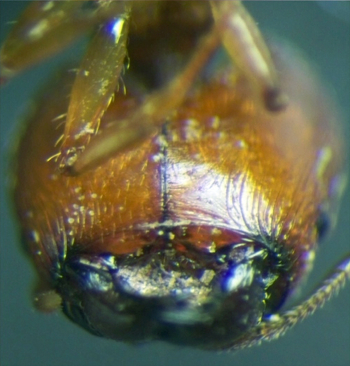 |
| . |
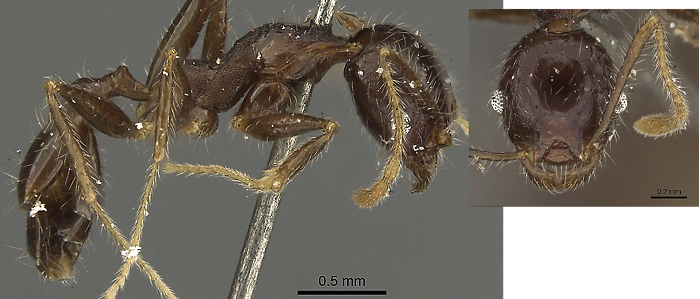
TL
ca 4.0 mm, HL 0.75, HW 0.66, SL 0.88, PW 0.44; CI 88, SI 124; scapes
surpass occiput by about two-fifths their length;
funiculus segments generally longer than wide; whole of body and tibiae
with long pilosity; head with noticeable sculpturation; brown with
reddish appendages. |
West Africa & Congo
Basin - aurivillii |
|
| - |
Colour brown or lighter |
-- |
|
| 42 |
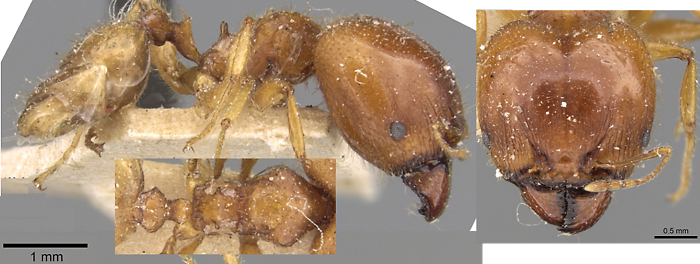
TL
5.8-6.2 mm, HL 1.89, HW 2.0, SL 0.67, PW 0.95; CI 109, SI 43; head
widest in posterior fourth |
. |
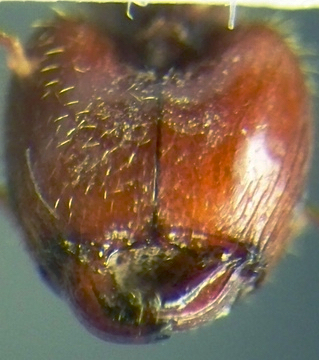 |
| . |

TL
3.0-3.2 mm, HL 0.68, HW 0.59, SL 0.65, PW 0.38; CI 90, SI 110; like punctulata but darker & a
little
larger; sides of head more strongly striated, frontal area more wider
and more angular behind; pronotum with transverse raised dark area;
propodeum and sides of mesonotum more strongly reticulate; generally
brownish to reddish-brown |
Southern
& eastern Africa - rotundata |
|
| -- |
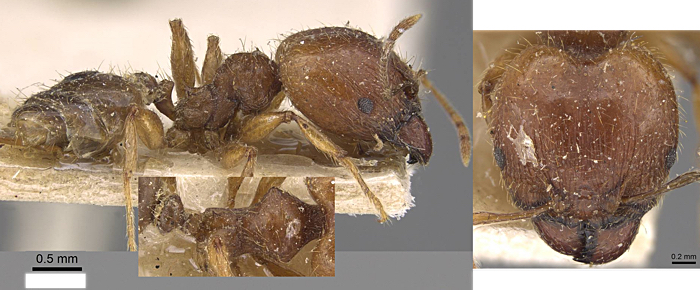
Type TL ca 4.7 mm,
HL 1.47, HW 1.53, SL 0.70, PW 0.77; CI 104, SI 46
West African TL
< 5.0 mm, proportions similar; colour brown to testaceous,
appendages not significantly
different |
. |
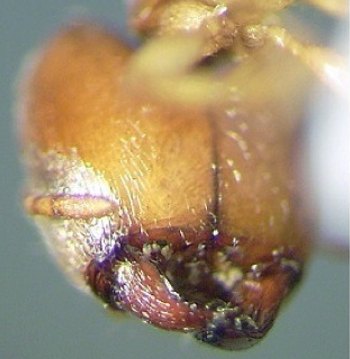 |
--
|

TL
2.43 mm, HL 0.68, HW 0.62, SL 0.72, PW 0.39; CI 81, SI 123; alitrunk
almost all over spiculate, fainter on the dorsal and lateral
pronotum;.red-brown, gaster darker but seemingly with diostinctive pale
patches (also on major), appendages lighter. |
Nigeria
& Cameroun (atrocior form)
- impressifrons |
|
| -- |

Minor only known - original description inadequate
TL 2.7 mm vs punctulata 3.0
mm; HW 0.6 vs 0.67; HL 0.62 vs
0.71; PW 0.35 vs 0.41. Postpetiole L = W; punctulata L < W;
CI 89 vs 89; SI 118 vs 107
|
South Africa - irritans |
|
| -- |
 TL 4.2-4.5, type ca
5.0 mm, HL 1.57, HW 1.64, SL 0.79, PW 0.79; CI 106, SI 48; in
profile anterior of head deeper than
posterior; promesonotum with very convex profile; propodeal teeth small
directed backwards and upwards; pilosity sparse of long yellowish
semi-erect hairs; mandibles and posterior of head very shiny, rest less
so due to reticulo-striation; dark reddish-brown to light brownish-red,
head always darker than alitrunk; TL 4.2-4.5, type ca
5.0 mm, HL 1.57, HW 1.64, SL 0.79, PW 0.79; CI 106, SI 48; in
profile anterior of head deeper than
posterior; promesonotum with very convex profile; propodeal teeth small
directed backwards and upwards; pilosity sparse of long yellowish
semi-erect hairs; mandibles and posterior of head very shiny, rest less
so due to reticulo-striation; dark reddish-brown to light brownish-red,
head always darker than alitrunk; |
|
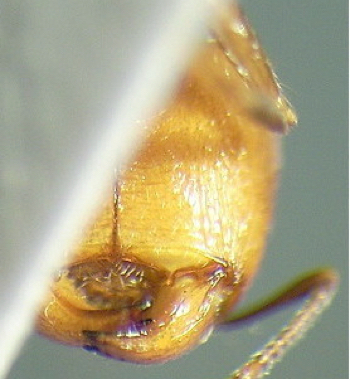 |
| . |

TL
2.7-3.0 mm, HL 0.74, HW 0.68, SL 0.74, PW 0.40; CI 92, SI 120; mostly
smooth and relatively shiny,
propodeum dull and reticulate; variable brown to yellowish-brown |
Pan-African
- punctulata |
|
 |
Head in full-face view with only moderately convex
sides
|
-- |
|
| 43 |
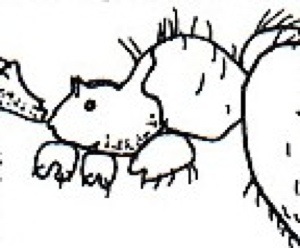
TL < 3.4 mm;
alitrunk profile smoothly domed, as is
propodeal profile, propodeal spines reduced to sharp denticles |
44 |
|
| -- |
TL > 3.4 mm |
46 |
|
| - |
Alitrunk profile
smoothly domed, as is
propodeal profile, propodeal spines reduced to sharp denticles |
-- |
|
| 44 |
Scapes and frontal
carinae reaching beyond midpoint of face |
45 |
|
|

Frontal
carinae reaching just short of the midpoint of the head; scapes
distinctly curved; alitrunk with only a low transverse welt; propodeal
spines short and acute; postpetiole width and length about the same;
erect hairs moderately abundant; head only faintly spiculate in the
soldier but with fine longitudinal carinae or rugulation on most of the
anterior half; colour orange, gaster very dark brown.
TL 2.89 mm, HL 1.18, HW 0.93, CI 79, SL 0.50, SI 54, PW 0.44 |
.
|
|
|
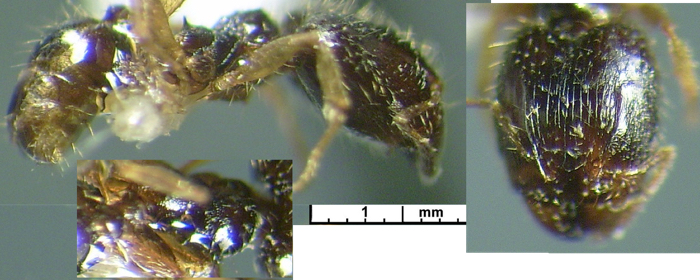 |
.
|
 |
| . |
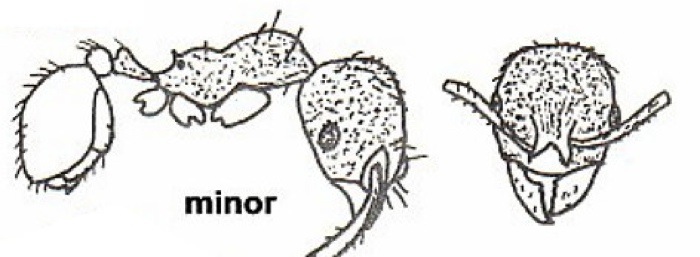
TL
1.9 mm, HL 0.47, HW 0.42, SL 0.47, PW 0.26; CI 90, SI 112; dorsum of
head and entire alitrunk densely
spiculate; erect hairs moderately abundant; orange, gaster very dark
brown. |
West Africa - new species
- crinensis |
|
| - |
Frontal
carinae reaching at least mid-point of head - postpetiole from above
laterally ovoid with sharp to slightly produces apices
|
-- |
|
| 45 |
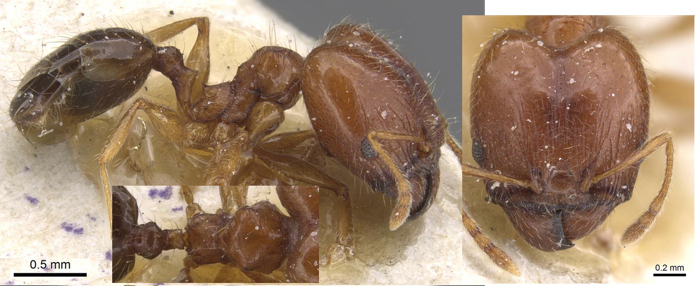
TL 3.2-3.4 mm, HL
1.10, HW 1.10, SL 0.60, PW 0.46; CI 100, SI 55; head with quite
strongly scalloped occipitum, sides convex, frontal notch deep and
contiguous with occipital groove, clypeus without a median carina;
frontal carina very divergent and as wide apart as long, hardly
reaching mid-point of face, scape reaches posterior third of head;
pronotum with angular sides, propodeum with dorsum and declivity
strongly bordered; head mostly smooth and shiny; body with long erect
hairs, irregularly spaced but abundant; red-brown, gaster darker |
. |
 |
| . |
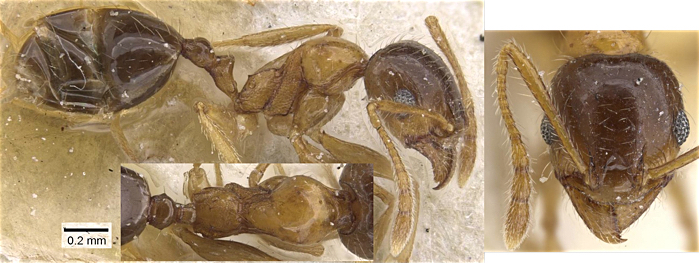
TL
2.0-2.4 mm, HL 0.54, HW 0.48, SL 0.56, PW 0.34; CI 86, SI 115; head
rectangular slightly longer than wide,
posterior angles rounded, occipital border straight and weakly
impressed (?); eyes set at mid-length and about one-quarter the length
of the head; scape surpasses occiput by about one-fifth its length,
segments 4-6 of funiculus wider than long, club with apical segment as
long as two preceding together; promesonotum smoothly arcuate;
propodeum with rectangular dorsum, longer than wide, almost flat and
sub-bordered.angles dentate; head, pedicel and gaster, blackish brown;
alitrunk and appendages pale reddish brown |
Sahel zone - decarinata |
|
--
|
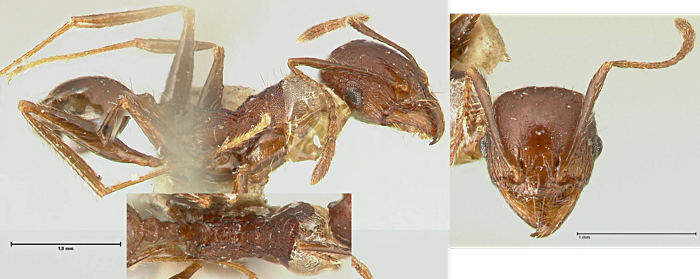
Major unknown; minor TL
|
Tanzania or Kenya
- scabriuscula |
|
 |
TL > 3.3 mm
|
-- |
|
| 46 |
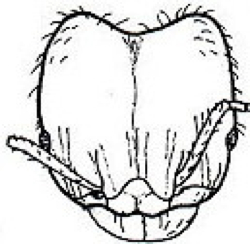
Head with only shallow occipital scalloping; in profile occiput
somewhat flattened |
48 |
|
| -- |
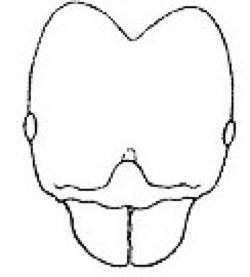
Head
with deep occipital scalloping; in profile occiput smoothly convex |
47
|
|
| 47 |

TL ca 3.5 mm, HL 1.08, HW 1.00, SL 0.53, PW 0.38; CI 96,
SI 54; frontal carinae
short and not forming scrobes, scape not reaching posterior third of
head; promesonotum smoothly convex without any impression or welt,
truncate behind and margined on each side; sculpturation limited to
anterior striations on head and a few striations and reticulations on
lateral propodeum (minor similar); erect pilosity yellowish sparse on
body and absent from tibiae and scapes; brownish-yellow, legs and
antennae dirty yellow |
. |
|
| . |
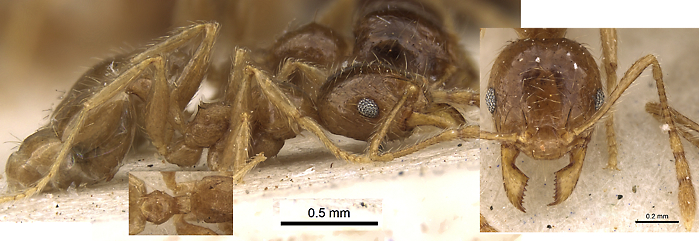
TL
2.5 mm, HL 0.56, HW 0.53, SL 0.57, PW 0.32; CI 92, SI 114; head
oval-rectangular, mandibles dentate, striate near the
base; clypeus without a carina, feebly emarginate; mesonotum with two
small ridges behind; propodeum subdentate; sculpturation limited to
anterior striations on head and a few striations and reticulations on
lateral propodeum; erect pilosity yellowish sparse on body and absent
from tibiae and scapes; brownish-yellow, legs and antennae dirty yellow |
South Africa - kitschneri |
|
| -- |

TL
3.5-3.8 mm HL 1.09, HW 1.09, SL 0.54, PW 0.50; CI 100, SI 50; clypeus
without a distinct median carina, striations on front of head extending
back to mid-point; light chestnut brown
|
. |
|
| . |
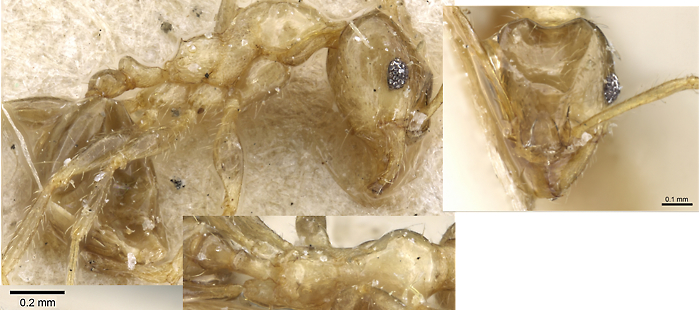
TL
1.8-2.0 mm; propodeal spines minute; pale greyish yellow, extremities
more brown, gaster more brown (note specimen has a damaged head, colour
suggests it is a callow)
|
Ethiopia - philippi |
|
| -- |

TL 4.0-4.5 mm; HL 1.44, HW
1.56, SL 0.78, PW 0.67; CI 103, SI 50; uniquely with
posterior border of basal two segments of
gaster having a row of triangular depressed tubercles, each giving rise
to a long hair; sides of head more convex than megacephala
and occiput more deeply scalloped, frontal carinae slightly longer than
the scape and with weak scrobe; head with frontal striations reaching
three-fifths point of face, most of alitrunk and pedicel finely
reticulo-punctate, some transverse irregular rugae on pronotal dorsum;
most of body pale rust yellow, head and scape darker, posterior of
gaster and most of legs whitish |
. |
 |
| . |
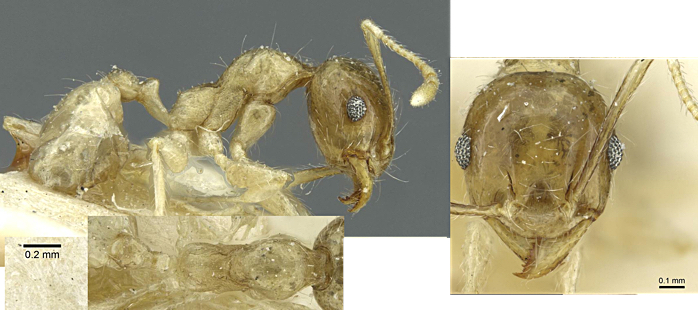
TL ca 3 mm, HL 0.67, HW
0.60, SL 0.86, PW 0.34; CI 85, SI 165; less elongated; the illustrated
specimens were
associated with majors and are darker than the type description of
generally very pale; most of body pale rust yellow, head and scape
darker, posterior of gaster and most of legs whitish
Type: TL ca 2.7 mm, HL 0.67, HW 0.57, SL ?, PW 0.32; CI 85, SI ca 130
|
Cameroun
& Zaïre - albidula |
|
| -- |
Border of two basal
segments of gaster without tubercles; head widest at about two-thirds
of length |
60 |
|
| -- |

TL 4.5- 5.0 mm; HL 1.78, HW
1.72, SL 1.17, PW 0.62; CI 95, SI 61; head with distinctive trapezoidal
shape in full face view; head with distinctive
reticulate sculpturation; scapes reaching hind-third of head; alitrunk
narrow and slender; proportions of head and alitrunk like in pallidula
and sinaitica; propodeal teeth small; postpetiole twice as wide
as petiole, laterally blunt; pilosity as in caffra; mostly matt
and somewhat punctate; brownish-red, appendages brown, antennae dull
yellow; related to aurivilli |
. |
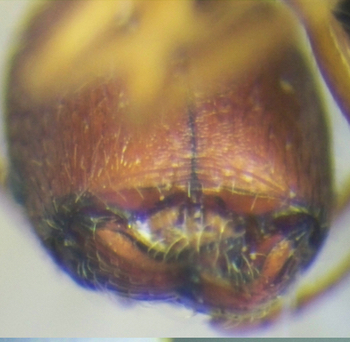 |
| . |

TL
2.5-2.8 mm, HL 0.72, HW 0.66, SL 0.81, PW 0.39; CI 89, SI 132; head a
long oval longer than wide; antennal
insertions with a distinct narrow margin; scapes surpass occiput by
about two-fifths their length; narrow nuchal collar present; mesonotum
with two transverse ridges; brown-yellow, head and hindleg brown,
gaster darker; somewhat similar to
aurivilli |
Ethiopia
- escherichii |
|
| 57 |
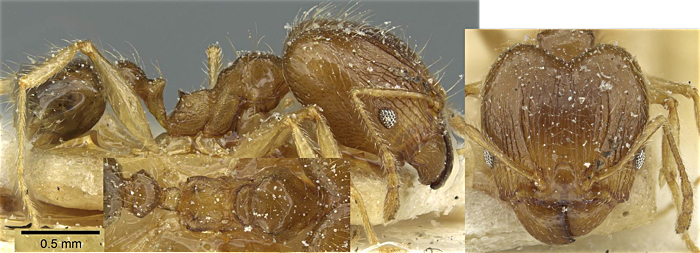
TL 3.5 mm; HL 1.08, HW 1.04,
SL 0.60, PW 0.32; CI 96, SI 56, OI 12;
head with quite strong longitudinal striations
reaching the occiput; other than striations head, like most of body
smooth and shiny, anterior pronotum, sides of propodeum and pedicel
superficially reticulo-punctate; whole of body with long fawn hairs;
brown yellow, centre of head and apical border of mandibles brown,
anterior half of gaster pale yellow rest brown black
REVISE
|
. |
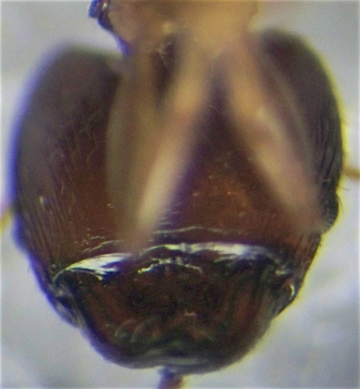
|
| . |
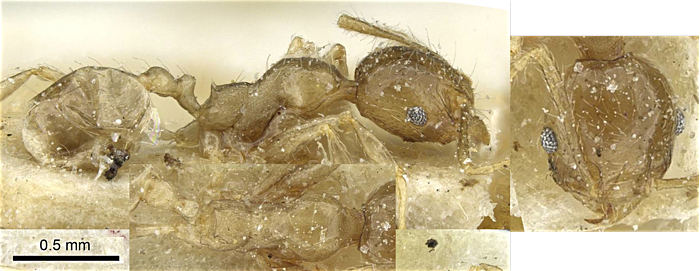
TL
2.2 mm, HL 0.54, HW 0.47, SL 0.59, PW 0.32; CI 88, SI 115; head ovoid,
semi-circular occiput; front area an
isoceles triangle extending quite far back between the frontal carinae;
eyes set about the mid-point; scape surpassing occiput by about
one-fifth its length; promesonotum profile a low regular curve, from
above lozenge-shaped with strongly rounded sides; propodeum dorsum flat
with anteriorly oblique slope out of the metanotal groove, declivity
concave only one-quarter the length of the dorsum, spines as long as
two-thirds their interval and often slightly curved anteriorly;
mesonotum punctuate as in a powder; abundant long fine pilosity; clear
brownish yellow, head darker, mandibles antennae and legs yellow;
gaster dirty yellow in front passing to brownish-black behind
REVISE
|
West
Africa & Congo Basin - squalida |
|
| -- |

TL
4.0-4.5 mm; HL 1.44, HW 1.44, SL 0.72, PW 0.54; CI 100, SI 50-55, OI
12;
frontal carinae reaching the mid-point
of the face and weakly divergent; mandibles quite large and heavy but
with a thin inner, masticatory margin; two basal teeth and two sharp
apical teeth; sculptured basally with rugae but dorsally with fine
striations and distinctive minute hair pits giving rise to an abundance
of short, thickish decumbent hairs; propodeum dorsum with sharp lateral
margins and a distinct longitudinal groove which widens from front to
back;dark red-brown, with the gaster and mandibles darker |
. |
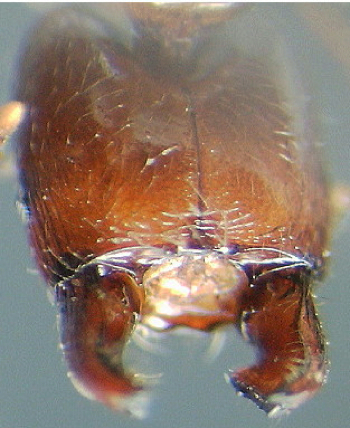 |
| . |

TL
ca 2.3 mm, HL 0.66, HW 0.55, SL 0.69, PW 0.33; CI 87, SI 120, OI
28, MI 36 , PI 60; head a short rectangle with
the sides very weakly convex, posterior angles broad and evenly
rounded, the occiput straight; with a very narrow nuchal collar;
mandibles moderately long, with a mixture of minute teeth and quite
coarse teeth on the masticatory margin; and two larger apical teeth;
anterior margin of clypeus quite strongly convex, without a median or
any other carinae; with only four forward facing, fine long hairs.
Colour variable with types seemingly lighter
|
North Africa & Mali -
cicatricosa |
|
| -- |

TL 3.7-4.0 mm; HL
1.70, HW 1.58, SL , PW 0.52; CI 97,
SI 70, EI 22; funiculus segments 2-5
length = width; eyes twice as big as pallidula, head striated
less far back so that the scape reaches beyond the striations, clypeus
with a weak median that is not raised; postpetiole profile almost
circular; (probably not sub-Saharan)
|
. |
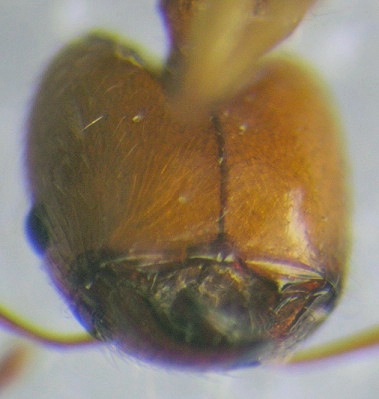 |
| . |
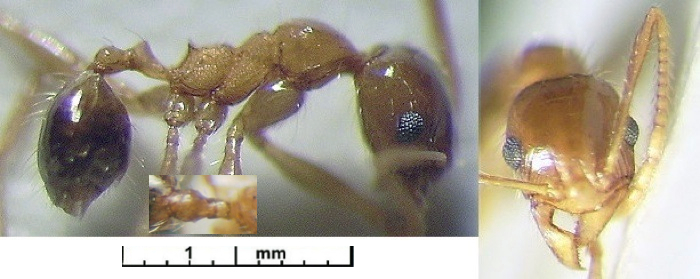
TL
ca 2.5 mm, HL 0.64, HW 0.52, SL 0.78, PW 0.35; CI 80, SI 141; head much
paler; legs much longer and
distinct groove between pro-and mesonotum (probably not from
sub-Saharan) |
North Africa & Sudan
- jordanica |
|
 |
THead with only
shallow occipital scalloping; in profile occiput
somewhat flattened
|
-- |
|
| 48 |
Base colour
orange-brown
|
49
|
|
| -- |
Base colour brownish-black
|
50 |
|
| 49 |

TL
3.5-4.5 mm variable, HL 1.50, HW 1.50, SL 0.80, PW 0.60; CI 100, SI 54;
promesonotum profile quite a high dome; propodeal
spines acute and sharp but distinct; postpetiole profile with distinct
angular ventral process |
. |
 |
| . |

TL
ca 2.5 mm, HL 0.67, HW 0.58, SL 0.68, PW 0.39; CI 86, SI 120; shiny,
with only sculpturation on mesonotum,
propodeum and petiole, all of which are densely spiculate; red-brown,
gaster darker, appendages lighter. |
Pan-African
tramp - megacephala |
|
|
| -- |
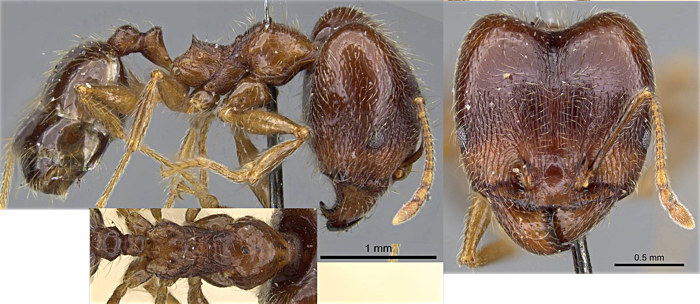
TL
4.5-5.1 mm, HL 1.64, HW 1.58, SL 0.83, PW 0.58; CI 96, SI 55;
striations on front of head reach back to about 2/3, occiput smooth and
shiny; colour piceous, appendages lighter; covered in quite abundant,
long fine hairs, legs and scapes distinctly bristly
|
. |
|
| . |

TL
2.8-3.0 mm, HL 0.75, HW 0.75, SL 0.75, PW 0.50; CI 100, SI 100;
shining, no pro-mesonotal suture; mesothorax
and propodeum lightly rugo-reticulate; dark brown to piceous,
appendages lighter
|
South Africa - foreli |
|
| 55 |

TL
3.5-4.5 mm variable, HL 1.50, HW 1.50, SL 0.62, PW 0.60; CI 100, SI 41;
promesonotum profile quite a high dome; propodeal
spines acute and sharp but distinct; postpetiole profile with distinct
angular ventral process; distinctive reticulate sculpture on the genae
|
. |
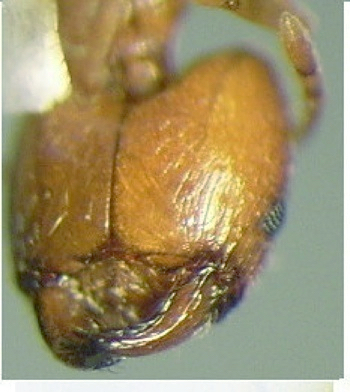
|
| . |
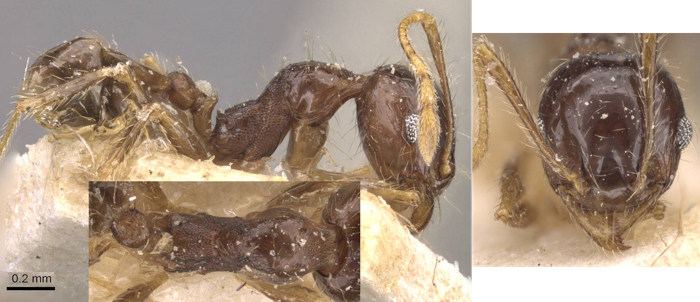
TL
ca 2.5 mm, HL 0.67, HW 0.58, SL 0.68, PW 0.39; CI 86, SI 120; shiny,
with only sculpturation on mesonotum,
propodeum and petiole, all of which are densely spiculate; red-brown,
gaster darker, appendages lighter. |
South
Africa to South Sudan
tramp - atrox |
|
|
| -- |
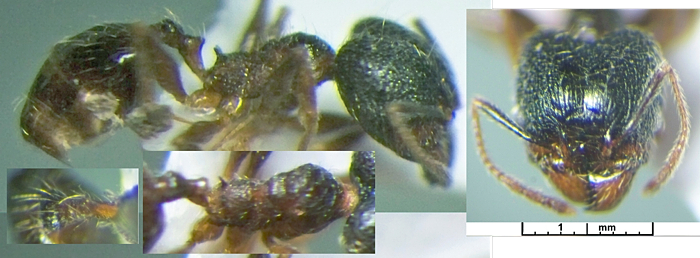
Major - dense sculpturation and abundant erect hairs seems
close to the minor worker below. TL ca 3.2 mm, HL 0.81, HW 0.67, SL
0.97, PW 0.42; CI 86, SI 150; PPI (postpetiole width over postpetiole
length) 125
Diagnosis uncertain not scabriuscula (see above)
|
. |

|
.
|
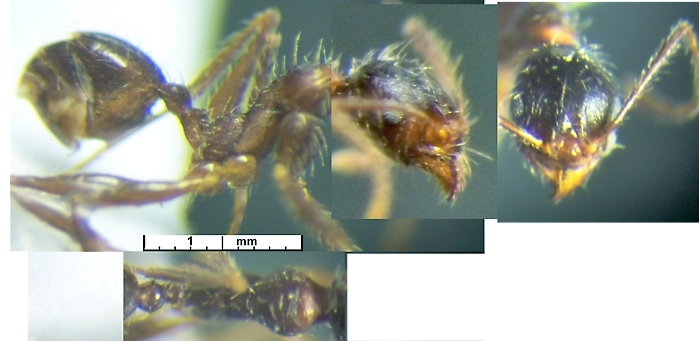
Minor - TL ca 3.2 mm, HL 0.81, HW 0.67, SL 0.97,
PW 0.42; CI 86, SI 150; PPI (postpetiole width over postpetiole length)
125 |
Ethiopia (minor) Sudan (major) Pheidole nsp Sudan - Ethiopia |
|
|
 Top of page Top of page
|
|
|
|